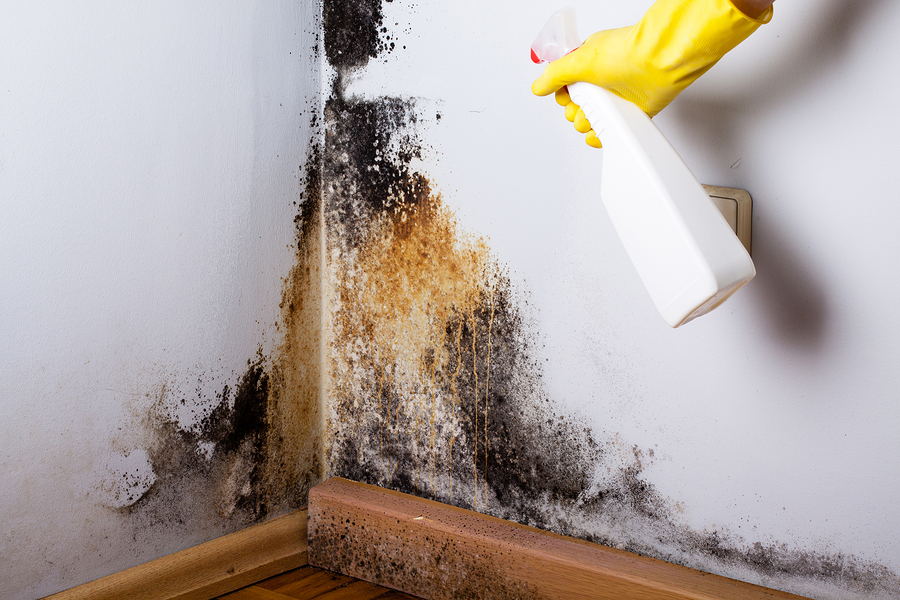- Make It Yourself Lavender Heart-Shaped Bath Bombs!
- 20 Things You Never Knew About “Down There”
- 12 Best Foods For Those Suffering From Arthritis Pain
- 12 Personal Hygiene Mistakes Almost Everyone Makes (Mom Never Told You About #4!)
- 15 Medicinal Plants And Herbs From The Cherokee People
- 12 Mind-Blowing Benefits Of Drinking Coconut Water During Pregnancy
- 12 Outstanding Winter Foods That Won’t Fatten You Up Like A Christmas Turkey
Mold… Plenty Of Ways To Keep It From Reoccurring!
1. Mold removal with bleach.
Bleach is probably the number one recommendation for mold removal. Apparently, it can kill any type of indoor mold, leaving the surface sanitized and resistant to future outbreaks. However, bleach cannot penetrate into porous surfaces (such as drywall or wood) and can be efficiently used on non-porous materials, like glass and tiles only. No wonder bleach can be effective against mold. The active ingredient in bleach, sodium hypochlorite, is also the main ingredient in a number of commercial products advertized for mold removal.
Yet, there are disadvantages in using bleach. First, you need to be careful with it as it may discolor the surface, so it is best to try out its effectiveness on a small area. Also, you need to wear gloves and ensure there’s good ventilation in the room when working with it because bleach produces harsh fumes dangerous for your respiratory system.
To kill mold with bleach, use about 1 part bleach with 10 parts water. Mix both liquids well in a spray bottle. Apply to surface. You don’t need to wipe it off, just let it dry out itself.
2. Mold removal with ammonia.
Ammonia, in its action and negativities, is pretty similar to bleach. You can apply it successfully on non-porous surfaces only, and have to be really careful while using it because it is toxic. Please note that you need to use the type which is labeled as ‘clear ammonia’. Make sure you never mix ammonia and bleach because together they create a deadly gas.
For killing mold, you need to mix one part of ammonia and the same one part of water in a spray bottle. Spray the mixture around the moldy surface, let it sit for an hour or two, then rinse with water, and wipe dry.
3. Mold removal with borax.
Borax is used a lot as a cleaning agent, and it does help against mold as well. Borax is not that toxic, it does not emit chemical fumes (unlike a number of other mold inhibitors), and does not cost much.
In order to use it to kill mold, mix well 1 portion of borax with 8 portions of water to create a paste-like solution. Scrub the mold surfaces using a brush with the borax-water mixture. After doing this, wipe up the remaining bits with a dry cloth and let the surface dry naturally.
4. Mold removal with vinegar.
Vinegar is also considered a relatively safe liquid to use to kill mold. It is neither toxic, nor its fumes dangerous. However, it is viewed that it kills up to 80 percent of mold species only.
To kill mold, you need to use white vinegar alone without diluting it with water. All you need to do is simply poor the vinegar into a spray bottle and mist it on the moldy surface. Leave it for an hour, then wipe away with water, then dry with a cloth. You may consider spraying some vinegar to the mold-prone areas every time you do the cleaning. It will help you protect the surfaces from mold reoccurring.
5. Mold removal with baking soda.
Baking soda has earned its reputation as a natural and safe powder used for household cleaning, and it helps for killing mold as well. Baking soda has an 8.1pH level, so it is safe to use. Besides, this powder will help you get rid of any odors which mold may leave in your house.
In order to kill mold, it will be more effective to mix baking soda with vinegar as they kill different types of mold and are working better together. Use one teaspoon of baking soda and a cup of water. Mix well all together in a bottle, then spray the mixture around, and scrub the surface with a brush. Then remove any residue with water, and let the surface dry out.
6. Mold removal with hydrogen peroxide.
Hydrogen peroxide is safe to use, both for you and the environment. It possesses anti-fungal, anti-viral, and anti-bacterial properties, which is just what is needed to kill mold.
You can use it effectively on a number of surfaces, like walls, floors, bathroom fixtures, as well as kitchen appliances, and even clothes. However, it may bleach out, so make sure you try it out on a small patch to ensure the area does not fade out.
To kill mold with hydrogen peroxide you need to use a 3 per cent concentration of hydrogen peroxide. Spray it around the moldy surface and let it sit and saturate for 10-15 minutes. Then scrub the area to remove any the residuals of the mold and its spores.
Make sure you store the bottle with hydrogen peroxide in a dark place in order to preserve its effectiveness.
7. Mold removal with tea tree oil.
Tea tree oil is the most effective and all-natural solution for killing mold. Though this oil is expensive, it is worth it. Yet, you need to remember that tree oil is a strong essential oil which can be dangerous to people and pets. Avoid direct contact with the oil.
To kill mold with tea tree oil, spray the mixture of one teaspoon of the oil and one cup of water around the moldy surface. Don’t wipe it or anything, just let it dry out naturally. As a variation, you may soak a sponge into the above mentioned solution and scrub the surface. Besides, tea tree oil leaves a nice scent in the room for a while. You have to keep the oil and the mixture in a dark place, as the essential oil loses its potential in the sunlight.
8. Mold removal with grapefruit oil.
Grapefruit oil, or grapefruit seed extract, just like tea tree oil, is an effective mold killer. Other citric oils such as orange or lemon oil have similar potential. These oils will deodorize the room as well.
To kill mold with grapefruit oil, take 1 teaspoon of oil and 1 cup of water, mix well together in a bottle, and spray around. Do not clean it off afterwards. Grapefruit solution has a long potential and can be stored for a long time in a dark cool place.
READ ALSO: Is Mold In Your House Making You Sick? Infographic
9. Mold removal with detergent.
On non-porous surfaces you may try using detergent mixed with water in similar portions (one to one ratio). Detergent itself does not kill mold, but it will help you to wash the surface completely, leaving it clean without mold.
BONUS TIPS! Read on even more of daily strategies to avoid mold from appearing!
Continue to Page 3

































